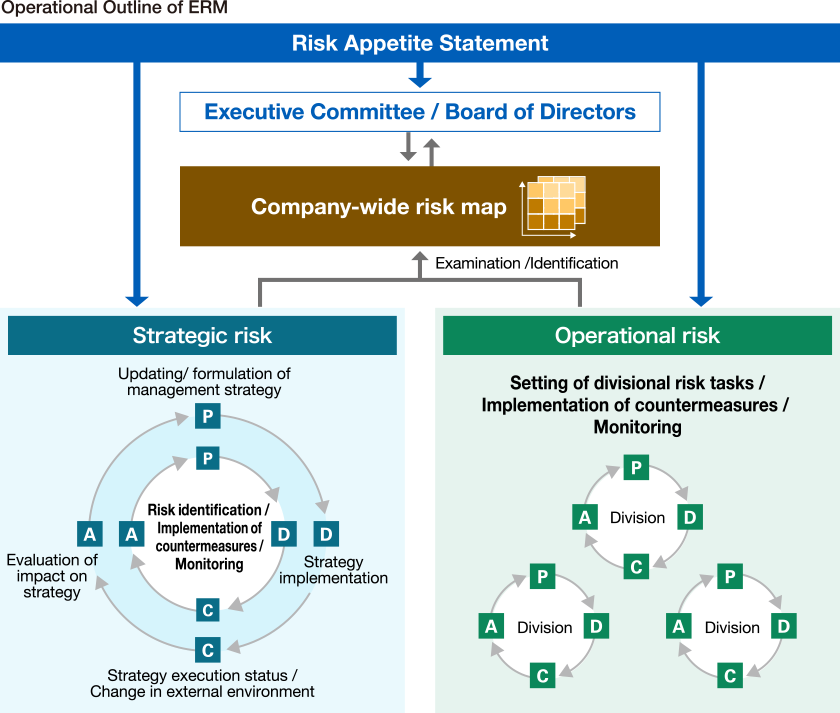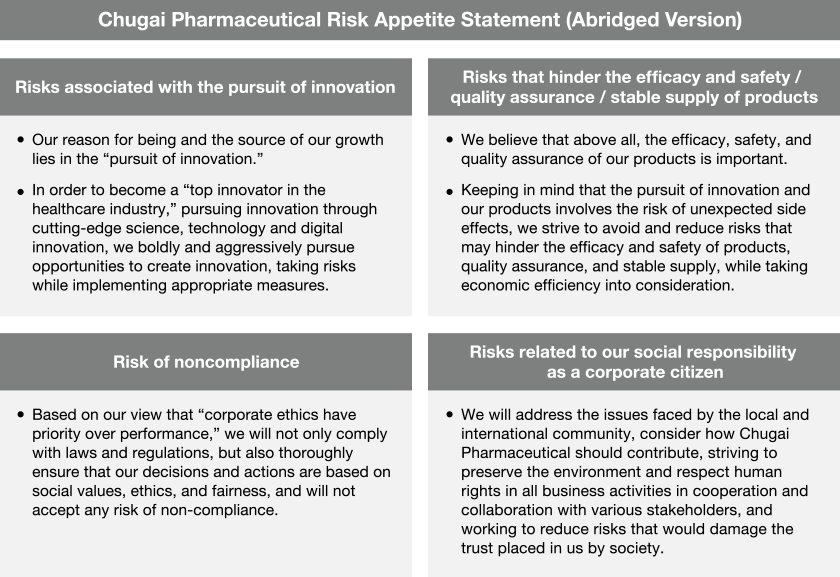Risk Management
Corporate activities are affected by various uncertainties (risks) that exist internally and externally. Proper management of risks is therefore essential in maintaining and increasing corporate value. At Chugai, risk management is a key issue underpinning sustainability, and we strive to evolve it every day.
Chugai’s Mission Statement is the basis of the business activities we pursue to create shared value with society and increase corporate value. In these business activities, the Chugai Group regards risk as any phenomenon that affects the achievement of management goals and the execution of strategy.
1. Advanced Risk Management through ERM
The Chugai Group has introduced Enterprise risk management (ERM) framework that visualizes all risk relating to business activities and manages it integrally to promote effective and efficient risk management by identifying, organizing, and visualizing events (risks) that could affect the achievement of business objectives and strategic execution. We have formulated the Risk Appetite Statement to clarify policy on risk preferences with the aim of creating a healthy risk culture. We divide risks to be addressed on a company-wide basis into strategic risk (risk inherent in strategic decision-making and risk that affects strategy execution) and operational risk (risk that affects smooth business operations) and implement risk management on a company-wide basis.
We disclose such information every year in our Annual Report and Corporate Website.
Please refer to “Business Risks” for detail.

2. Chugai Pharmaceutical Risk Appetite Statement
To support appropriate strategic decision-making and smooth business operations, we have formulated the Risk Appetite Statement that sets out our policy in response to risk. We work to cultivate a healthy risk culture and ensure that all employees consistently make judgments and take actions in accordance with this culture.
Please refer to “Chugai Pharmaceutical Risk Appetite Statement” for detail.

3. Strategic risk management
When identifying and evaluating “strategic risks,” we identify important risks that are expected to have a major impact on its management strategy through information gathering from external reports, regular analysis of business environment trends, and interviews with relevant departments, and assess the impact on strategies, and take appropriate measures in timely manner.
Specifically, in the midst of dramatic changes in the company environment, such as the remarkable development of science and technology and the transformation of the social system accompanying the rise of AI, the risks associated with “Technology and Innovation,“ “Healthcare System and Regulation,“ “Markets and Customers,“ and “Business Foundation“ are identified as critical risks in the execution of the growth strategy “TOP I 2030.“ For identification and evaluation, we coordinate with key material issues (materiality) and conduct annual reviews.
4. Operational risk management
The Chugai Group strives on a daily basis to appropriately manage operational risks, which affect the smooth operation of business activities. Specifically, we identify operational risks in each division, assess residual risks based on the impact and probability of occurrence and the effectiveness of countermeasures, then formulate annual response plans each year for the risks that should be prioritized.
Risk Management Frameworks and Initiatives
Chugai has established the Risk Management Policy and Risk Management Regulations and set up a Risk Management Committee as a corporate management committee, as well as Division Risk Compliance Committees in each division and at subsidiaries in Japan and overseas.
The Risk Management Committee monitors risk management in each division with a Company-wide perspective, evaluates reports from the Division Risk Management Committees, and submits reports to the Executive Committee as necessary. It also identifies Group-wide risk issues as “Chugai Group Risk & Compliance Challenges” that may have a material impact on management, taking into consideration the status of response by the relevant divisions and trends in the industry and external environment and report the progress of company-wide measures to the Risk Management Committee when necessary, to the Executive Committee and Board of Directors.
Division Risk Compliance Committees create and quantitatively evaluate risk maps that identify the risks in the business activities of their respective divisions. To address priority risks, which are division risk compliance action plan, the Division Risk Compliance Committees draw up annual response plans and report regularly the progress of the plans to the Division Risk Compliance Committees and the Risk Management Committee Secretariat.
Chugai Risk Management System

Using IT Systems to Boost Risk Management Efficiency
To promote more efficient identification, analysis, and feedback of company-wide risk information, Chugai developed an risk management system and implemented it globally. Using the database for centralized management, divisions can record their risk maps, annual risk response plans, and incident reports. This enables us to analyze risks for the Group as a whole and monitor countermeasures at each division.

Emergency Response System
If a problem arises in a division or at a subsidiary, the division or subsidiary involved will respond immediately and report to the Risk Management Committee Secretariat.
In the event of a large-scale disaster or serious problem, an Emergency Headquarters led by the CEO and a cross-divisional Risk Response Subcommittee will be set up to carry out Company-wide emergency response measures.
In addition, a Business Continuity Plan is in place for responding to business continuity risks (e.g., a major earthquake, pandemic outbreak or cyber-attack), and drills are conducted periodically.

